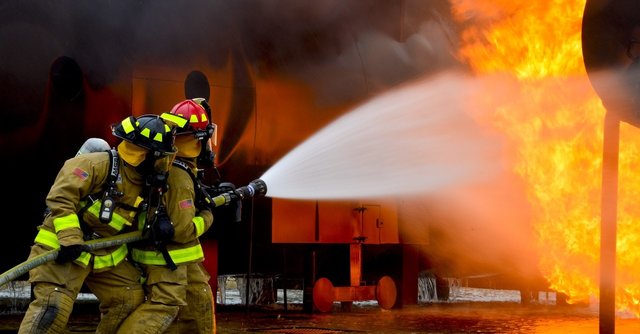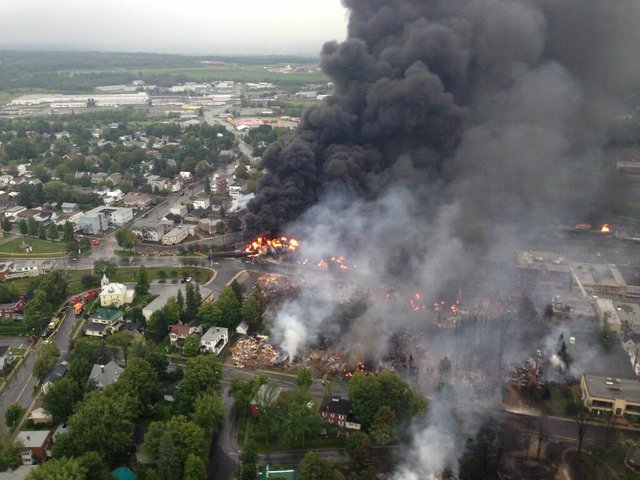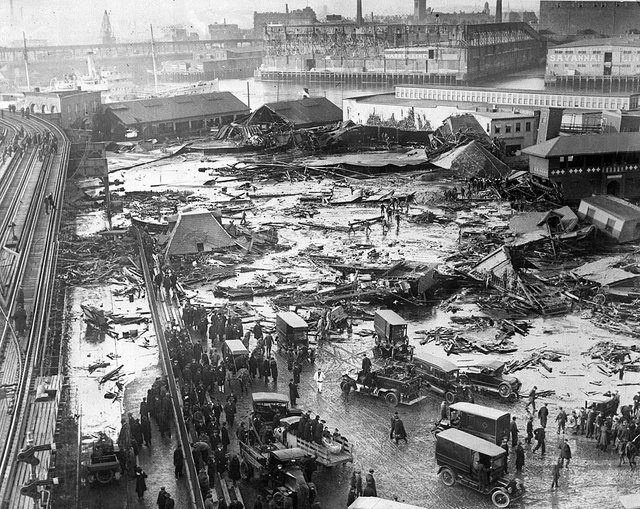Learning From The Intercontinental Terminals Corp Fire In Houston & Other Industrial Disasters

Over the last few days the situation near Houston has been one of fire and fear.
The fire at Intercontinental Terminals Corp in La Porte, TX, just outide of Houston has been raging since the morning of March 17 and authorities are now unsure just how long the situation could go on. This means all hands on deck for a lot of emergency personnel and a lot of strain on all the resources needed to contain the fire to just the tanks that are hopelessly lost.
The fire cannot just be put out but most be allowed to burn out totally.
What tanks are on fire?
At the moment the tanks burning contain Naptha and Xylene. Naptha is "white gas" and used as an additive in gas. The chemical Xylene is used as a solvent and is known as being extremely flammable. Common products xylene is used in include:
- Aerosol paint concentrates
- Epoxy adhesives,
- Auto and machinery paints,
- Caulk
- Coatings used on machinery
- Remover for oily coatings
- Small amounts are added to automotive and airline fuels
- 2 of these tanks hold Naptha
- 4 contain Xylene
- Each tank holds the equivalent of 80,000 barrels.
Authorities may have lifted the shelter in place order, but that means little to the neighborhoods that have been enduring plumes of black smoke.
Those that live in the Deer Park suburb were ignoring the shelter in place order that occured. This is fairly common during emergencies and sometimes the consequences are not always as good as they have been in these cases.
Residents were doing things like driving with a shirt over their mouth and keeping car vents closed in order to pick up kids early on in the event when there was a shelter in place order. As least having a respirator on hand would make it safer and reduce the risk of being overcome by fumes when driving.
Update Tuesday March 19: While on Monday firefighters seemed to be able to keep the fire from spreading but a temporary drop in water pressure Monday night gave the blazes the window of opportunity to intensify.
Tuesday March 19, 8:38 am Eastern Standard Time: 8 tanks are burning but two are empty. It is believed that the first two tanks, containing Naptha, have almost burned out. This means 6 tanks of highly flammable Xylene are blazing away.While officials were predicting 2 more days of burning, now they are reluctant to predict how long this fire could go on. As of now there is no shelter in place order and schools in the area are open. People are being reassured about air quality but it is hard to imagine the quality could be anything close to good.
Live Feed from KHOU Houston 11
Industrial accidents can occur anytime and anywhere.
The lesson is to be aware of the potential industrial hazards in your area and prepare as much as possible. Be cautious about believing that air quality and other factors are as good as what you are told by companies and the government.
Nuclear
A lot of the United States lives within a concerning range of a nuclear facility. Not only that, but radioactive materials are transported all the time on American highways.
Surviving a nuclear incident is dependent on how close you are and the nature of the incident. A huge explosion is different than a deteriorating situation where you have some time to act.
The Chernobyl Exclusion Zone versus Fukushima Exclusion Zone
Sometimes it is assumed that the exclusion zone around a nuclear incident should be in the 40 mile range due to that being what was set in the catastrophic Chernobyl reactor explosion in 1986. In the case of Chernobyl, a single reactor was in involved. Fukishima was far worse with 3 reactors melting down.
Russia is a big country, and they purposely put the Chernobyl reactor in a remote area and built the city of Pripyat around it. They had enough unoccupied or lightly occupied space in between that they could afford to give up such an expanse of land.
In the case of Fukushima, it is situated in a densely populated area. Japan is short on space and high in population thus the exclusion zone is far smaller even if for safety and health sake, it should be much broader. Just because the government says the zone should be this or that doesn't mean your health and wellbeing is not at extreme risk
Chemical
It does not take much for an area to have to be evacuated quickly. Some chemicals and gases have very serious consequences. During the mid-90s at the local paper mill there was a chlorine gas explosion that killed 7 people and led to the entire town center being evacuated. Chlorine gas dissipates fairly quickly but you still may need to stay away for a day or longer.
Some chemical contamination incidents may take a lot longer. You may not be able to go back to your home to retrieve anything at all for many days. Make sure to take pets with you if you even the threat is supposedly minor. It is not worth the risk.
Items to have on hand
- Respirator rated to handle Volatile Organic Compounds
- Long sleeve clothing. Cover your skin as much as possible to prevent contact.
- 6 bottles of saline solution for rinsing eyes
- Baking soda for neutralizing strong acids
- Spray bottle for mixing acid neutralizer
- Read the treatment guidelines and put together a kit. If you can find out the major chemicals used at plants nearby you can gain a lot of knowledge
Biological
If you live near a facility that handles biological waste or conducts medical research, there are few things you can do to be more prepared.- Keep disinfectants on hand
- Have several water filters that are capable of removing viruses. There are a ton of these on the market at a reasonable cost
- Keep disposable respirator masks as well as large professional respirators to avoid breathing in biological contaminants
Agricultural chemicals
Fertilizer is particularly prone to explosions. In 2015 the Port of Tianjin experienced a series of massive explosions that were started by an overheated container of dry nitrocellulose. This led to a second explosion of 800 tons of ammonium nitrate. The enormous second explosion caused fires to burn for days and 8 additional small explosions to occur. While the actual death count was stated to be 170, with many hundreds more injuries, it is likely that the casualties were far worse considering how densely populated the area is.Fuel
Gas explosions can happen so fast. In 2012, a gas plant explosion occurred due to a leak. 26 people were killed. Here is a video so that you can see what can happen when a leak leads to a major explosion.
Warning! This is quite graphic to watch.
Things to have on hand:
- An excellent trauma and medical kit
- Extra supplies for treating burns
- Respirators
- Clothing that is not synthetic. If you wear synthetic clothing while trying to get out of a zone where there is fire, if you happen to catch fire, your clothing will melt to your skin, making the burn much worse than a mere ember falling
- Fire extinguishers for your home and car. Getting out of a fire zone is scary and you want to have something on hand to put out any minor fires
Transport disasters
While oil spills at sea are what many imagine when they think of fuel spills, the Lac-Mégantic rail disaster that occurred in Quebec, Canada on July 6, 2013, proves that a disaster an make its way through your town via railway. Many cities have railroad tracks going through them and most are carrying a variety of things, including industrial chemicals, fuel, and oil.
In the case of the Lac-Mégantic rail disaster, a 74 car long train carrying Bakken Formation Crude Oil derailed in the downtown area and destroyed more than half the buildings in the downtown area. The contamination for the accident resulted in only 3 buildings in the downtown area being salvage. The chemical contamination was too great for any other buildings, so they had to be destroyed. 42 people lost their lives and 5 more were never found. It is believed that the explosion was enough to vaporize them.

This is an example of a disaster that is impossible to totally prepare for but having some basic supplies to get through the aftermath is recommended. Being able to stay at home while there is a caouos and uncertainty may keep you safer. Monitor the situation and adapt your plan as needed.
Industrial scale food production disasters
Just because it is food being produced, doesn't mean a major even cannot happen. In 2008 in Port Wentworth, Georgia, a sugar refinery owned by Imperial Sugar exploded. The cause was due to a dust explosion. This type of explosion occurs when fine particles in the air rapidly combust. The explosion killed 14 people and injured an additional 40. Imperial posted a major loss for the quarter. Old and outdated equipment and facilities were blamed for the incident.
Consider how much old and outdated equipment is still being used in the US today. It is hard to know how much but there are plenty of companies risking the safety of workers and those nearby to avoid footing the bill for modernization. It is impossible for you to know if a facility is out of date, but a warning sign is industrial plants that have been in operation for far longer than modern work place safety standards have existed.
The Boston Molasses Flood of 1919
In the North End of Boston on January 19, 1919, a huge storage tank containing molasses burst open sending 2.3 million gallons of molasses down the street in a huge wave that topped out at around 35 mph! The wave of sticky molasses killed 21 people and left 150 injured along with a lot of infrastructure destroyed.

Buildings were flattened and people and animals alike were overtaken or bogged down by the molasses. Several blocks of the North End were flooded with 2-3 feet of the liquid.
Specialized gear and planning should be tailored to your situation.
Create an evacuation and survival plan for the most likely situations to occur in your area. I always will believe that a cornerstone of the prepping and survivalist mindset is being able to take knowledge and apply it to your unique situation. You can learn a lot from studying a variety of scenarios and situations but yours will always be different.
It may be that you live in a zone with enough industry that you need to be prepared for a variety of potential situations. Luckily a lot of the gear is the same with just a few changes.
To Do
- Make a list of nuclear plants within 50 miles
- Consider what types of industry and businesses are within 5 miles of you
- List the most likely disasters that could happen with any potential industrial hazard you have on your list.
- Prepare for the most likely scenarios
What are the wind patterns?
Wind can carry particles of all description various directions. If the wind blows one way and there is a nuclear plant in the area, you may be at a higher risk for radiation fall out than an area equally close that faces the opposite direction of the way winds are blowing.Shelter In Place Supplies
Workplaces and offices should have some basic items on hand if everyone needs to shelter in place for safety reasons. Here are a few things to have on hand.- Water
- Foods that can be eaten by everyone. There are a lot of people with food allergies. Stick to foods that are not likely to cause allergic reactions.
- Duct tape and plastic sheeting
- Group medical kit
- Something for entertainment such as a few decks of cards. If computers and other devices can be used, then it is easy for people to find something to read or watch but it that becomes unavailable, boredom and restlessness can kick in fast
- A few battery banks for keeping phones topped off for communications in case the situation becomes more extended
Have a meetup location if an event happens, and family is scattered.
If you have a point that can work for everyone to agree to meet at in case of an industrial incident, then it can be very helpful during the more chaotic points. Of course, this may not work out, but it is good to try at least to designate a safe spot to meet.If you have a bug out location, make sure you know more than a few ways to get to it.
An industrial disaster may block more than one way to get to your bug out destination. Know a few routes and keep a good map in your car or your bug out bag.Understand that you may not be able to return to your home for a long time in some situations. The residents near the Fukushima plant were stripped of all their possessions including their clothing.
Conclusion: Situational awareness and the ability to react quickly and adapt as a situation unfolds is critical to getting through any major event including industrial disasters.
I think industrial accidents may become more common place as companies value profits over upgrades and worker safety during a tough economic environment. Aging industrial plants and infrastructure eventually lead to failures when there is no budget for modernization.
Posted from my blog with SteemPress : https://www.samanthabiggers.com/2019/03/19/learning-from-the-intercontinental-terminals-corp-fire-in-houston-other-industrial-disasters/